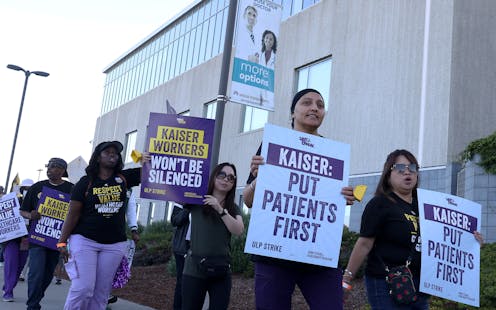Health care workers gain 21% wage increase in pending agreement with Kaiser Permanente after historic strike

The Coalition of Kaiser Permanente Unions reached a tentative agreement with its employer on a new four-year contract on Oct. 13, 2023. They agreed following the largest documented strike of U.S. health care workers on record, which involved more than 75,000 workers in several states and the District of Columbia. A majority of the unions’ 85,000 members will need to approve the deal for it to become final. The voting began on Oct. 18.
The contract’s terms will make Kaiser “able to deliver on our mission of providing high quality, affordable and accessible health care to our members,†Kaiser Vice President and Chief of Human Resources Greg Holmes said.
The Conversation asked Michael McQuarrie, an Arizona State University sociologist who directs its Center for Work and Democracy, to explain what’s in the settlement and why it matters.
What are the terms of the settlement?
Kaiser workers will get a 21% raise over the life of the contract, with a 6% salary increase in October 2023, and 5% in October 2024, 2025 and 2026.
The contract notably also includes a new hourly minimum wage for Kaiser workers in California, which will increase to US$25 by 2026. That pay level will be required of all California health care employers by that time, however, because California Gov. Gavin Newsom has signed a new law to that effect.
In other states, the contractual minimum hourly wage will be $23 once all of the raises called for in this new contract are phased in.
The contract also calls for some improvements to benefits, such as larger performance-related bonuses. The final settlement reportedly includes a guaranteed performance bonus of at least $1,500 if Kaiser meets financial benchmarks and patient health benchmarks.
Bonuses for working shifts that include hours after 5:30 p.m. would rise to $3.25 an hour, I’ve learned from workers involved in the negotiations. That means if this contract is ratified, these evening and night shifts would see an increase from $2 in the 2019-2023 contract. Without that monetary incentive, workers usually try to get more desirable daytime shifts, increasing turnover and exacerbating staffing gaps at night.
The new contract would also leave in place restrictions on Kaiser’s ability to outsource or subcontract union jobs, which were included in the prior contract that Kaiser and the unions agreed upon in 2019.
And the coalition of unions has agreed to streamline the process for internal bidding on open positions to help Kaiser resolve staffing shortfalls. In addition, the contract includes provisions for training new health care workers that the union had sought.
Why did workers feel the strike was necessary, and did it achieve their aims?
My contacts within the union told me that they had the impression that Kaiser had essentially withdrawn from negotiations in the weeks leading up to the strike – although its management team did return to the table at the eleventh hour before the strike began. The bargaining officially began in April 2023.
The unions in the coalition had rejected the terms Kaiser was offering at that point, which included lower wages and plans to expand its reliance on subcontracted workers. Kaiser also never responded to the coalition’s last economic proposal until the last-minute negotiations that failed to avert a strike.
The COVID-19 pandemic strained relations between Kaiser’s managers and workers to unprecedented levels. United Healthcare Workers West/SEIU, the coalition’s largest union, surveyed its members in 2022 and found a heavily stressed workforce who felt that management was unresponsive to their concerns. Numerous academic studies support these findings.
Kaiser has been seeking for months to hire 10,000 new workers by the end of 2023 to fill vacancies that have led to understaffing and put stress on its workforce.
That Kaiser’s engagement in talks with the unions increased after the strike suggests that the unions’ actions made a big difference. So does the fact that Kaiser ultimately agreed to terms that were closer to the unions’ original demands on wages, benefits and subcontracting once workers went on strike than it had previously said it would accept.
How have workers responded to the proposed settlement?
Union members have to vote in favor of ratification for this contract to go into effect. Leaders of the strike and workers who were involved in the negotiations have told me they’re optimistic that this will happen. Voting began on Oct. 18 and should conclude by Nov. 3.
![]()
Michael McQuarrie works with and does research on unions and other organizations. The Center for Work and Democracy has received funding from United Healthcare Workers West/SEIU, which is part of the Coalition of Kaiser Permanente Unions.